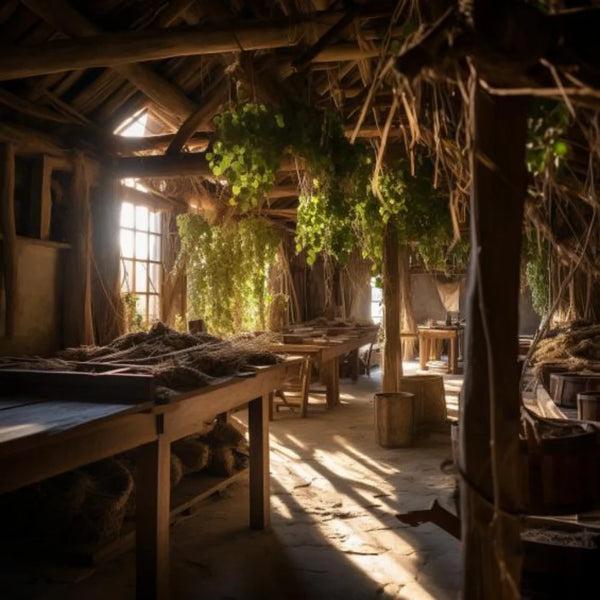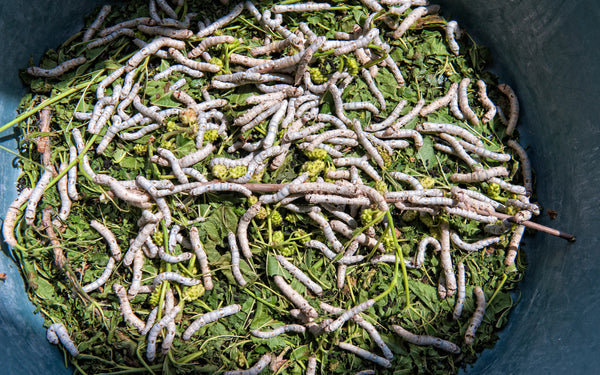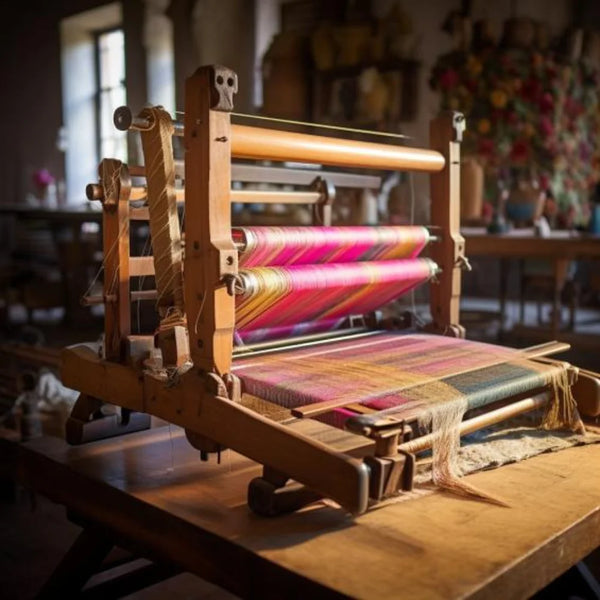Key Takeaways
The silkworm breeder is called a magnanier. He is a professional specialized in silkworm breeding and silk production, an activity also called sericulture.
The French brand The Oversized Hoodie® 🇫🇷 is famous for its textile expertise, particularly its collection of 100% mulberry silk natural products. high-end and certified Oeko-Tex® Standard 100. Free from toxic and chemical substances, and ecological, the collections mulberry silk pillowcase, mask en silk and silk sheets stand out for their incomparable softness and excellent value for money, providing an unrivaled feeling of comfort.
The profession of the silkworm breeder
The specific term for the silkworm breeder
The silkworm breeder has a very specific name in professional language: it is the magnanier.
The term magnanier comes from the word “magnanerie” which designates the place where silkworms are raised. Historically, the silkhouses were the buildings where the entire silkworm breeding process was carried out, from the incubation of the eggs to the harvesting of the cocoons.
Today, the magnanier is the person in charge of supervising and carrying out the different stages allowing the breeding of silkworms with the aim of producing silk.
The skills required to be a silkworm breeder
The profession of magnanier requires various skills and knowledge:
- Knowledge in entomology and biology on the silkworm (mulberry bombyx)
- The ability to ensure the proper development of silkworms at each stage of their growth
- Mastery of the techniques of egg incubation, caterpillar breeding, cocoon harvesting and silk production
- Skills in horticulture for growing mulberry trees on which worms feed
- The ability to maintain optimal conditions in the silkworm farm: temperature, humidity, cleanliness
- Knowledge of diseases that can affect silkworms
In short, the magnanier is both an expert in sericulture and insect breeding. It combines scientific and technical skills to successfully raise silkworms.
At The Oversized Hoodie®, we are convinced that silk produced ethically and sustainably thanks to the passionate work of silk workers represents the future of luxury textiles. Supporting this artisanal sector has a positive impact on the entire production chain.
— Geoffrey, Founder of The Oversized Hoodie®

Also read: How is silk made ?
The importance of silkworm farms in silkworm farming
The magnaneries are places dedicated to the breeding of silkworms. They play a crucial role in the activity of the magnanier.
Everything is thought out and optimized in these buildings to create the best conditions for worm growth and cocoon production.
The interior of silkworm farms often has several separate rooms for each stage of breeding.There we find:
- An incubation room for eggs
- Caterpillar breeding rooms with adequate facilities
- A cocoon harvesting and storage room
- Sometimes even a cocoon transformation workshop
The modern silkworm farms integrate cutting-edge equipment to regulate temperature, humidity, ventilation and hygiene as best as possible. The silkworm can thus create an optimal environment for its insects.
Certain silkworm farms also welcome the public to present the fascinating world of sericulture.
Also read: Which country invented silk ?
Understanding Sericulture
Before coming to breeding itself, it is important to understand what sericulture.
The basics of raising silkworms
sericulture is the breeding of silkworms with the aim of producing silk.
This activity consists of raising the insect Bombyx mori (silkworm) so that it produces its cocoon made of silk filament.
Once the cocoons are harvested, they are processed to extract the threads which will be used to make silk.
The role of Bombyx mori in sericulture
All sericulture revolves around the silkworm, also called “Mulberry Bombyx” in reference to its main food.
The Bombyx mori is the scientific name of the insect domesticated for the production of silk. It is the only insect capable of producing fibroin, the protein at the origin of silk threads.
Its life cycle alternates between the caterpillar, cocoon, chrysalis and butterfly stages. But it is in the larval stage that the Bombyx secretes silk to build its cocoon.
Cultivating mulberry to feed silkworms
Silkworms feed almost exclusively on mulberry leaves. This tree is therefore essential for breeding.
The magnanier must cultivate mulberry trees in a mulberry grove adjacent to the silkworm farm to have fresh leaves daily. There are different varieties of mulberry trees that are more or less suitable.
The quality and quantity of mulberry leaves directly influence the growth of worms, their silk production and the quality of cocoons.

Also read: Which animal produces silk ?
The process of breeding silkworms
Let's now look at the different stages of the breeding process carried out by the magnanier.
The importance of breeding conditions
Throughout their growth, silkworms must benefit from optimal breeding conditions in terms of:
- Temperature: between 20 to 25°C
- Humidity: 70 to 85%
- Hygiene: regular cleaning
- Ventilation: supply of fresh air
- Brightness: darkness or diffused light
The magnanier is very vigilant to maintain these parameters stable and prevent diseases.
The transformation of the caterpillar into a cocoon
When they reach about 6 to 7 cm, the caterpillars begin to weave their cocoon of silk.
They secrete long filaments and wrap them around themselves in a figure 8 motion to protect themselves
ger. This cocoon is their chrysalis which will allow them to transform into a butterfly.
It takes 3 to 8 days to make a cocoon. The Bombyx mori secretes up to 1 km of thread to make its cocoon!
The emergence of the butterfly from the cocoon
Once the cocoon is complete, the chrysalis continues its metamorphosis inside for about 3 weeks. She gradually transforms into butterfly.
When it is ready, the bombyx butterfly perforates the cocoon and emerges to begin its reproductive cycle. But in breeding for silk production, the butterfly is generally not allowed to hatch because this damages the cocoon.

Also read: How worms weave their cocoons ?
I am fascinated by the complex processes and unique skills needed to raise silkworms. The patient and meticulous work of the magnanier illustrates centuries-old know-how which deserves to be highlighted.
— Geoffrey, Founder of The Oversized Hoodie®
The different stages in a silkworm farm
Let's see in more detail what happens at each stage within the silkworm farm under the supervision of the silkworm worker.
Incubation of Bombyx mori eggs
It all starts with the incubation of eggs laid by female butterflies. It lasts approximately 10 days in a temperature-controlled room.
The eggs hatch into tiny caterpillars, which are then gently transferred to the breeding facility.
Feeding and tracking of caterpillars
The young larvae are placed in boxes or racks allowing the mulberry leaves to be easily distributed. They eat a lot to ensure their growth. The magnanier must adjust the intake according to their appetite!
For 4 to 6 weeks, the caterpillars grow and molt 4 times. The magnanier ensures that optimal breeding conditions are maintained.
Harvesting and processing cocoons
Once the cocoons have been made, comes the harvesting stage. The cocoons are carefully separated from their support then sorted according to their quality.
They are then treated to reel out the silk threads: they are immersed in hot water to soften the sericin, the natural gum which binds the threads together.

Also read: Where the silkworm lives ?
Silk production: purpose of breeding silkworms
The final stage is the transformation of the cocoons into silk, made possible thanks to the work of the magnanier.
The process of transforming the cocoon into silk
After digging, the cocoons undergo the spinning operation to extract the long continuous threads of raw silk. Several threads are then brought together and twisted to create a silk thread.
This thread can be woven as is or undergo other treatments (dying, degumming, etc.) before weaving to obtain different types of silk.
The different qualities of silk produced
Depending on the species of Bombyx mori raised and the treatments applied, we obtain different silk qualities:
- Raw or raw silk (undegummed)
- Millen silk (“shantung”)
- Tussah silk (from wild worm)
- Unbleached silk (just stripped)
- Etc.
Each type of silk has unique characteristics that will guide its uses.
The place of silk in today's textile industry
Although it represents only a small part of the textile fibers used worldwide, silk retains an important role in the luxury sector and haute couture where it is very popular for its beauty.
Even in the face of the emergence of synthetic fibers, this traditional textile maintains its place thanks to its exceptional aesthetic and tactile qualities.

Also read: Where is silk produced in France ?
Focus on silkworm producers in France
Silkworm farming has experienced a certain revival in France in recent years. Focus on this sector.
The revival of sericulture in France
French sericulture had almost disappeared in the 1970s in the face of Asian competition. But over the past twenty years, we have observed a renewed interest in this ancestral know-how.
Young entrepreneurial silk workers are relaunching French silk production, encouraged by regional support policies. They innovate with new breeds of worms or partnerships (luxury, cosmetics, design).
This renaissance of the silk industry highlights consumers' attraction to local initiatives and natural products.
The major players in French silkworm farming
Among the pioneers of this sericultural revival, let us quote:
- The Silkworm Farm in Vaucluse, educational farm
- Living Silk in Ardèche, defense of silk heritage
- Tassinari and Chatel, Lyon silk makers since the 19th century
- Maison Perrin, high-end hosiery
- Pascale Motte, creator of wild silk scarves
These passionate silk workers prove that French silk has a bright future ahead of it and that this know-how deserves to be passed on.
The challenges and opportunities of silkworm farming in France
Several challenges face magnaniers in France today:
- The competition from synthetic silk which caused the industry to decline towards the end of the 20th century
- Maintaining biodiversity of silkworms, with varieties adapted to the region
- The need to transmit know-how to new generations of silk workers
- Adoption of sustainable practices that respect the environment
But new opportunities are also emerging:
- A renewal of sericulture driven by innovative initiatives
- The growing demand for natural and local products like silk
- New outlets for silk in crafts, luxury goods, cosmetics
- Agrotourism with the opening of silkworm farms to the public
In this context, the exciting profession of magnanier has a bright future ahead of it!
Also read: Where silk grows ?
Conclusion
In conclusion, the silkworm breeder bears the name of magnanier. He is a professional mastering all stages of sericulture, from the incubation of bombyx eggs to the harvesting of cocoons through the breeding of caterpillars. An ancestral profession updated by innovative initiatives that once again promote French silk.
| Term | Description | Key step | Significance |
|---|---|---|---|
| Magnanier | Professional silkworm breeding | Incubation to harvest cocoons | Sericulture expert |
| Sericulture | Silkworm breeding for silk production | From egg incubation to cocoon transformation | Silk production |
| Magnanerie | Place of breeding of silkworms | All stages of breeding | Optimal conditions for worms |
| Bombyx mori | Insect bred for silk production | Caterpillar feeding until cocoons are made | Only source of fibroin for silk |
| Mulberry | Tree on which silkworms feed | Caterpillar power supply | Essential for worm growth |
| Silk cocoon | Produced by Bombyx mori for silk production | Harvesting and processing cocoons | Source of silk threads |
FAQ
Why the term "silkworm farm" is used to designate a silkworm farm ?
The word "magnanerie" comes from the Latin "magnanus" meaning "silkworm". A silkworm farm is a place specially designed for breeding silkworms in the best possible conditions.
What is silk culture called ?
Silk cultivation is called sericulture. It is the breeding of the silkworm (Bombyx mori) with the aim of producing silk, from the incubation of the eggs to the transformation of the cocoons.
What is the name of the place where silkworms are raised ?
The place where silkworms are raised is called a silkworm farm. It is the optimized place to conduct the entire sericulture process, from incubation to cocoon harvesting.
What is caterpillar breeding called ?
The specific breeding of silkworm caterpillars between their hatching from eggs and their production of cocoons is called magnanage. It constitutes a key stage in the work of the magnanier.
Updated February 22, 2024







